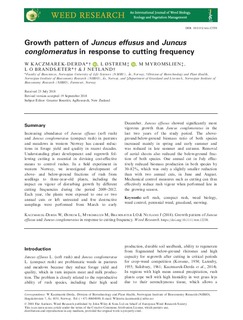| dc.contributor.author | Kaczmarek-Derda, Wiktoria Anna | |
| dc.contributor.author | Østrem, Liv | |
| dc.contributor.author | Myromslien, Merete | |
| dc.contributor.author | Brandsæter, Lars Olav | |
| dc.contributor.author | Netland, Jan | |
| dc.coverage.spatial | Norway | nb_NO |
| dc.date.accessioned | 2018-12-11T11:38:25Z | |
| dc.date.available | 2018-12-11T11:38:25Z | |
| dc.date.created | 2018-11-26T11:05:25Z | |
| dc.date.issued | 2018-07-23 | |
| dc.identifier.citation | Weed research (Print). 2018, . | nb_NO |
| dc.identifier.issn | 0043-1737 | |
| dc.identifier.uri | http://hdl.handle.net/11250/2577104 | |
| dc.description.abstract | Increasing abundance of Juncus effusus (soft rush) and Juncus conglomeratus (compact rush) in pastures and meadows in western Norway has caused reductions in forage yield and quality in recent decades. Understanding plant development and regrowth following cutting is essential in devising cost-effective means to control rushes. In a field experiment in western Norway, we investigated development of above- and below-ground fractions of rush from seedlings to three-year-old plants, including the impact on vigour of disturbing growth by different cutting frequencies during the period 2009–2012. Each year, the plants were exposed to one or two annual cuts or left untreated and five destructive samplings were performed from March to early December. Juncus effusus showed significantly more vigorous growth than Juncus conglomeratus in the last two years of the study period. The above-ground:below-ground biomass ratio of both species increased mainly in spring and early summer and was reduced in late summer and autumn. Removal of aerial shoots also reduced the below-ground fraction of both species. One annual cut in July effectively reduced biomass production in both species by 30–82%, which was only a slightly smaller reduction than with two annual cuts, in June and August. Mechanical control measures such as cutting can thus effectively reduce rush vigour when performed late in the growing season. | nb_NO |
| dc.description.abstract | Growth pattern of Juncus effusus and Juncus conglomeratus in response to cutting frequency | nb_NO |
| dc.language.iso | eng | nb_NO |
| dc.rights | Navngivelse 4.0 Internasjonal | * |
| dc.rights.uri | http://creativecommons.org/licenses/by/4.0/deed.no | * |
| dc.subject | Soft rush | nb_NO |
| dc.subject | Compact rush | nb_NO |
| dc.subject | Weed biology | nb_NO |
| dc.subject | Weed control | nb_NO |
| dc.subject | Perennial weed | nb_NO |
| dc.subject | Grassland | nb_NO |
| dc.subject | Mowing | nb_NO |
| dc.title | Growth pattern of Juncus effusus and Juncus conglomeratus in response to cutting frequency | nb_NO |
| dc.type | Journal article | nb_NO |
| dc.type | Peer reviewed | nb_NO |
| dc.description.version | publishedVersion | nb_NO |
| dc.rights.holder | © 2018 The Authors | nb_NO |
| dc.subject.nsi | VDP::Landbruks- og Fiskerifag: 900::Landbruksfag: 910 | nb_NO |
| dc.source.pagenumber | 10 | nb_NO |
| dc.source.journal | Weed research (Print) | nb_NO |
| dc.identifier.doi | 10.1111/wre.12338 | |
| dc.identifier.cristin | 1634959 | |
| dc.relation.project | Norges forskningsråd: 190492 | nb_NO |
| cristin.ispublished | true | |
| cristin.fulltext | original | |
| cristin.qualitycode | 1 | |

